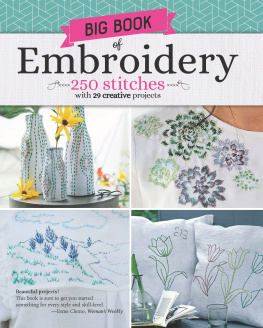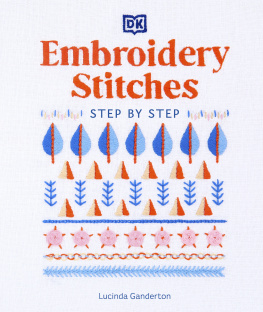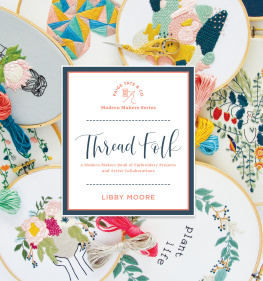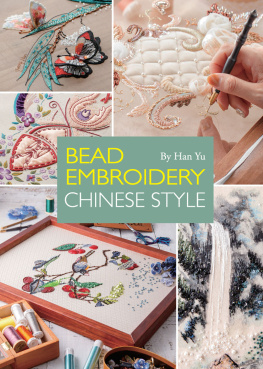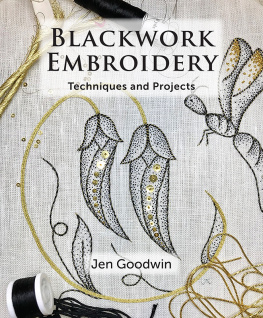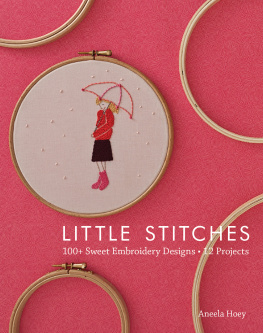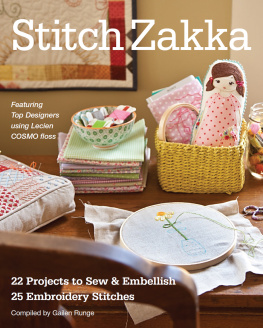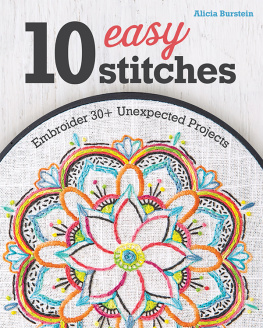

Scandinavian
STITCH CRAFT
Unique Projects and Patterns for Inspired Embroidery
KARIN HOLMBERG

2013 by Karin Holmberg
Published in North America by Running Press,
A Member of the Perseus Books Group
All rights reserved under the Pan-American and International Copyright Conventions
This book may not be reproduced in whole or in part, in any form or by any means, electronic or mechanical, including photocopying, recording, or by any information storage and retrieval system now known or hereafter invented, without written permission from the publisher.
Books published by Running Press are available at special discounts for bulk purchases in the United States by corporations, institutions, and other organizations. For more information, please contact the Special Markets Department at the Perseus Books Group, 2300 Chestnut Street, Suite 200, Philadelphia, PA 19103, or call (800) 810-4145, ext. 5000, or e-mail .
Library of Congress Control Number: 2013930107
E-book ISBN 978-0-7624-4856-2
9 8 7 6 5 4 3 2 1
Digit on the right indicates the number of this printing
Designed by Corinda Cook
Edited by Eva Kruk
North America edition edited by Cindy De La Hoz
Typography: Caslon, Eurostile, Fairfield, Filosofia, Franklin Gothic, and Professor
Running Press Book Publishers
2300 Chestnut Street
Philadelphia, PA 19103-4371
Visit us on the web!
www.runningpress.com


CONTENTS

Folk textile, folk costumes, and the rich tradition of embroidery in Sweden have long been my main sources of inspiration. Bright colors and fanciful patterns used to be combined in ways that were often highly original, fascinating, and at times a bit surprising. Not everything was grey homespun; rather, people put a lot of time and work into decorating everyday items. That says something of the human drive to be creative.
Embroidery is a way of personalizing home textiles and clothes; it is also accessible. All you really need to get started is a needle and thread and youll be ready to embroider almost anything. Embroideries are easy to take with you: sew on the train, at the coffee shop, or with friends.
The main purpose of this book is to inspire. If you still want to make the designs exactly as seen here, you can use the patterns in the back of the book. Tracing paper tucked into the back cover of the book will help. Trace the pattern onto the paper and use it as a guide as you stitch. I have selected eight classic regional embroideries and show how they can be done traditionally or developed in new directions. My hope is that you will discover the textile treasure trove that these embroideries constitute, as well as be inspired to interpret them in your own way. Take out the needle and start to embroider!



All embroidery techniques that I use in the book originate in old Swedish folk textiles. Often its not known precisely when a new technique came into use, or who was the first person to sew it, but most likely people were initially trying to copy exclusive woven damask fabrics. They then borrowed patterns and templates from one another, passing them back and forth between the homesteads. This is how, over time, certain embroideries became popular and distinctive to specific parts of the country.
Jrvs stitch was a way for peasant women to show off their own craft skill as well as the financial status of their farm. To display their work, every farm had one or more beds made with richly decorated bedding, intended only for show. Hanging linens and pillowcases were embroidered with red cotton floss. Some of the floss wasnt true Turkish red and has faded over time, so the embroideries now appear more pink. The motifs are various florals, more or less stylized. The techniques used are one-sided flat stitch and stem stitch. The Jrvs stitch is set apart by the characteristic tassels sewn with four or five stitches. In books this type of stitch sometimes goes by the name of tassel stitch. Jrvs stitch is fairly fast and easy to sew. It may be wise to secure the long stitches that make up the flowers with small stitches. This will help keep the embroidery in place.
Delsbo stitch is similar to Jrvs stitch, though the patterns tend to be slightly different. The motifs are usually flowers and leaves, but they are rounder than the somewhat more sprawling forms of Jrvs stitch. Delsbo stitch is also sewn using red cotton floss and one-sided flat stitch. Here it is common to secure the stitches with a garland of stem stitches around the center of the flower. The patterns were often drawn using cutout templates made from paper or birch bark. These were passed down through the generations and shared by several embroideresses. This practice might explain why many embroideries are so similar and stylized within a particular region.
Anundsj stitch is the only technique in this book associated with a specific person: Brita-Kajsa Karlsdotter. She lived in the ngermanland region in the nineteenth century and took up embroidery late in life. This is said to explain the somewhat shaky and charming style of this type of embroidery. According to one story about her, she would always ask her children and grandchildren to thread her needles when they visited. That way she could continue embroidering on her own. Here too the motif was red flowers with thin stems and lobed leaves. They were given their distinct look by her securing the long stitch with a small, diagonal one. A recurring theme is that she would embroider her initials: BKD, the year, and the letters RTHG, which is a Swedish acronym for the credit belongs to God. Anundsj stitch doesnt take much time to sew, and you neednt worry too much about the stitches being the same exact length; imperfection is part of its charm!
Halland stitch is most often seen on pillowcases. They are embroidered on just one of the short ends, as that is what can be seen from the room. The patterns differ quite a bit from other types of stitches. Halland stitch has a far more stylized and geometric type of design. It consists of circles, triangles, stars, and heart shapes; sometimes composed to form flowers and a sort of tree of life. Another distinctive trait is the laid filling stitch that fills the shapes. This is sewn by drawing up threads to form a net, either straight and along the thread or diagonally, which is secured using various types of stitches. The edges are neatly hidden using stem stitch, or chain stitch. One-sided flat stitch does occur, but it is more common to cover larger surfaces using herringbone stitch. If the stitches are too long, they can be secured using chain stitch, or stem stitch. Blue or red cotton floss is commonly used. By combining these two colors with different laid filling stiches one can create nearly infinite variations on this embroidery. Halland stitch demands a high level of accuracy, but you get into it quickly and I think it can be quite relaxing to simply fill circles with different stitches.
Next page

